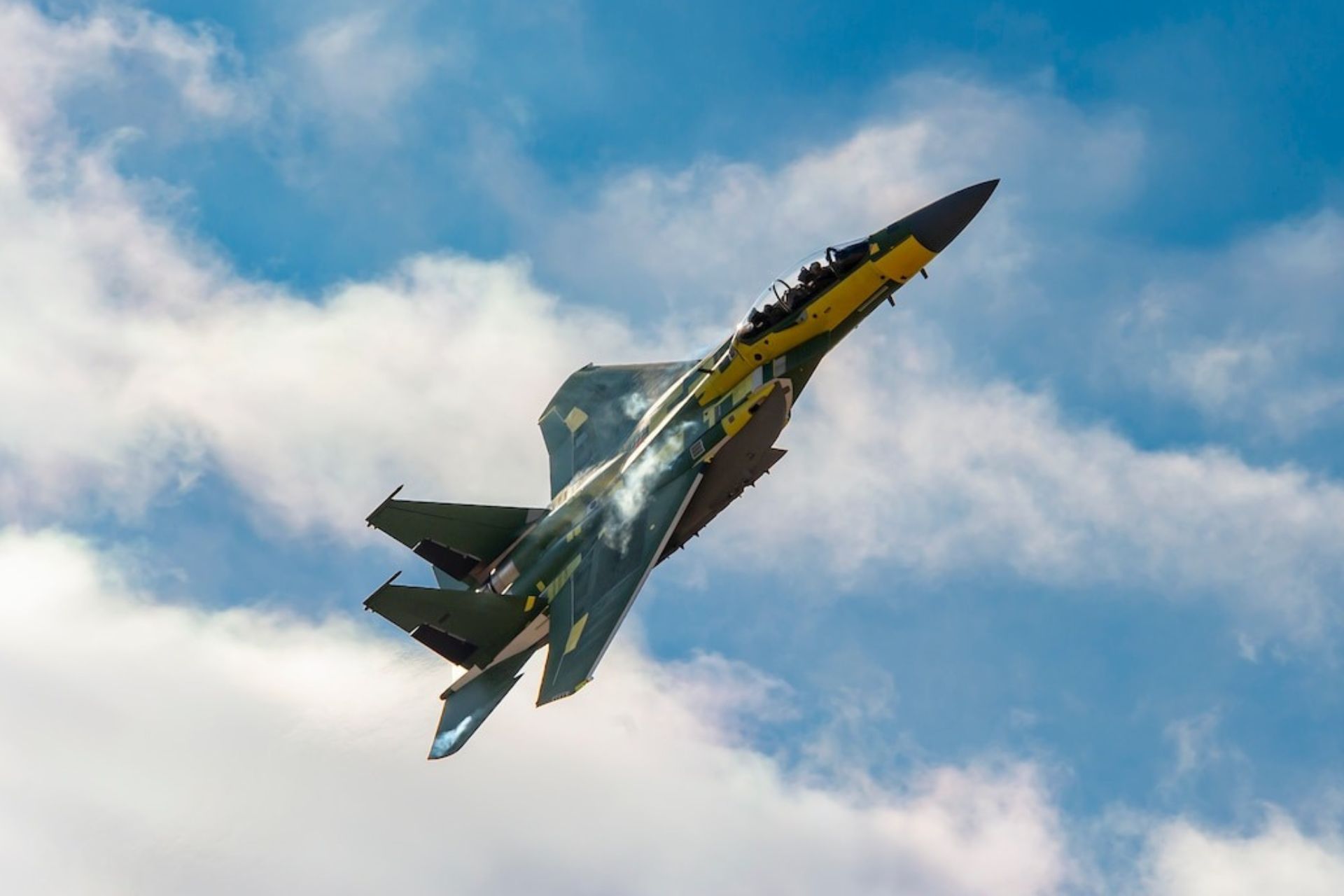US Accelerates F-15EX Eagle II Fighter Jet Production with $3.1 Billion Funding Boost

{loadposition bannertop}
{loadposition sidebarpub}
The United States has taken a step in modernizing its airpower by allocating an additional $3.1 billion to speed up the production of the F-15EX Eagle II multirole fighter aircraft. This investment, part of a broader $150 billion package targeting top-priority defense programs through 2029, reflects a strategic effort to maintain immediate operational readiness while concurrently developing more complex and costly sixth-generation platforms.
Follow Army Recognition on Google News at this link
The F-15EX holds the distinction of carrying the largest weapons payload among all U.S. fighter aircraft, with a capacity of up to 13,400 kg (Picture source: Boeing)
Developed by Boeing, the F-15EX Eagle II is the latest evolution of the legacy F-15, originally designed during the Cold War. Although it shares the same basic airframe as the F-15E Strike Eagle, the F-15EX has undergone a thorough modernization process to meet the demands of contemporary air combat, where electronic survivability, network connectivity, and long-range precision strike capabilities are critical operational requirements.
The F-15EX holds the distinction of carrying the largest weapons payload among all U.S. fighter aircraft, with a capacity of up to 29,500 pounds (13,400 kg). It can be configured to carry up to 22 air-to-air missiles, next-generation precision munitions (JASSM, JDAM), long-range air-to-air missiles such as the AIM-120D AMRAAM and AIM-260 JATM, and potentially hypersonic weapons like the ARRW (Air-Launched Rapid Response Weapon)—capabilities that stealth aircraft like the F-35 are not currently able to support in internal carriage configurations.
On the avionics and sensor front, the F-15EX integrates the AN/APG-82(V)1 AESA radar, which allows for simultaneous tracking of multiple targets in contested electromagnetic environments. It is paired with the AN/ALQ-250 Eagle Passive/Active Warning and Survivability System (EPAWSS), designed for threat detection and electronic countermeasures. The aircraft also includes the Legion Pod with the IRST21 sensor, enabling long-range passive detection of airborne targets and enhancing operations in emission-controlled (EMCON) scenarios.
One of the key technological innovations of the F-15EX is its Open Mission Systems (OMS) architecture. Unlike legacy aircraft with proprietary software systems, the F-15EX’s modular digital backbone allows for rapid integration of new sensors, effectors, and mission software. This open architecture supports incremental upgrades and faster responsiveness to evolving threats, streamlining software certification and reducing the dependency on long development cycles.
From an industrial perspective, the F-15EX benefits from an existing production line in St. Louis, Missouri, and a mature supply chain that has supported F-15 programs for the U.S., Saudi Arabia, Qatar, and South Korea. This industrial continuity enables predictable delivery schedules and cost efficiencies, which are critical at a time when more futuristic programs like NGAD (Next Generation Air Dominance) remain in advanced development phases with uncertain timelines.
A head-on view of an F-15EX (Picture source: Boeing)
Operationally, the F-15EX is distinguished by its rapid integration into existing force structures. Unlike the F-35, which requires specific infrastructure, training programs, and sustainment networks, the F-15EX can be adopted by legacy F-15 squadrons with minimal adaptation. The aircraft is certified for a 20,000-hour service life—more than twice that of earlier F-15 variants—offering long-term cost benefits and readiness continuity.
The deployment of 21 F-15EX aircraft to Selfridge Air National Guard Base in Michigan, replacing aging A-10 Thunderbolt II aircraft, illustrates the Pentagon’s intent to sustain robust domestic air capabilities while avoiding capability gaps. This deployment is expected to generate an economic impact of $850 million and support over 5,000 jobs in the region. Concurrently, the Pentagon has confirmed the forward deployment of 36 F-15EX aircraft to Kadena Air Base in Okinawa by spring 2026. This move supports U.S. strategic posture in the Indo-Pacific at a time of heightened tensions with China, which is expanding its J-20 stealth fighter fleet and asserting its military presence around Taiwan and the East China Sea.
The F-15EX is also designed to serve as a command-and-control node in future manned-unmanned teaming (MMT) operations. It is expected to coordinate Collaborative Combat Aircraft (CCA), acting as a forward airborne hub to manage ISR, electronic warfare, and strike drone formations. This role aligns with broader integration efforts under the NGAD and ABMS (Advanced Battle Management System) programs, which seek to achieve cross-domain integration and real-time battlespace awareness.
While the F-15EX does not offer full stealth capabilities like the F-35 or future sixth-generation platforms, it offsets that with greater payload, endurance, and system flexibility. In an increasingly contested global environment, where adversaries such as China and Russia are developing multi-layered air defense systems, stealth aircraft, and hypersonic threats, the F-15EX serves as a robust and immediately available solution.
Rather than competing directly with fifth or sixth-generation fighters, the F-15EX represents a pragmatic balance between performance, technological maturity, and fiscal sustainability. It fills a critical gap for the U.S. Air Force: providing a high-capacity multirole aircraft that is ready now, can integrate with future systems, and serves multiple mission profiles—from homeland defense and strike operations to force projection in joint or coalition frameworks.
The U.S. Air Force’s renewed investment in the F-15EX Eagle II underscores the importance of maintaining a diversified fleet structure that blends legacy modernization, next-generation development, and autonomous system integration. With its advanced capabilities, long-range versatility, and rapid availability, the F-15EX will continue to serve as a central component of U.S. tactical airpower through the 2030s and beyond, bridging the gap between today’s operational needs and the future of air dominance.

{loadposition bannertop}
{loadposition sidebarpub}
The United States has taken a step in modernizing its airpower by allocating an additional $3.1 billion to speed up the production of the F-15EX Eagle II multirole fighter aircraft. This investment, part of a broader $150 billion package targeting top-priority defense programs through 2029, reflects a strategic effort to maintain immediate operational readiness while concurrently developing more complex and costly sixth-generation platforms.
The F-15EX holds the distinction of carrying the largest weapons payload among all U.S. fighter aircraft, with a capacity of up to 13,400 kg (Picture source: Boeing)
Developed by Boeing, the F-15EX Eagle II is the latest evolution of the legacy F-15, originally designed during the Cold War. Although it shares the same basic airframe as the F-15E Strike Eagle, the F-15EX has undergone a thorough modernization process to meet the demands of contemporary air combat, where electronic survivability, network connectivity, and long-range precision strike capabilities are critical operational requirements.
The F-15EX holds the distinction of carrying the largest weapons payload among all U.S. fighter aircraft, with a capacity of up to 29,500 pounds (13,400 kg). It can be configured to carry up to 22 air-to-air missiles, next-generation precision munitions (JASSM, JDAM), long-range air-to-air missiles such as the AIM-120D AMRAAM and AIM-260 JATM, and potentially hypersonic weapons like the ARRW (Air-Launched Rapid Response Weapon)—capabilities that stealth aircraft like the F-35 are not currently able to support in internal carriage configurations.
On the avionics and sensor front, the F-15EX integrates the AN/APG-82(V)1 AESA radar, which allows for simultaneous tracking of multiple targets in contested electromagnetic environments. It is paired with the AN/ALQ-250 Eagle Passive/Active Warning and Survivability System (EPAWSS), designed for threat detection and electronic countermeasures. The aircraft also includes the Legion Pod with the IRST21 sensor, enabling long-range passive detection of airborne targets and enhancing operations in emission-controlled (EMCON) scenarios.
One of the key technological innovations of the F-15EX is its Open Mission Systems (OMS) architecture. Unlike legacy aircraft with proprietary software systems, the F-15EX’s modular digital backbone allows for rapid integration of new sensors, effectors, and mission software. This open architecture supports incremental upgrades and faster responsiveness to evolving threats, streamlining software certification and reducing the dependency on long development cycles.
From an industrial perspective, the F-15EX benefits from an existing production line in St. Louis, Missouri, and a mature supply chain that has supported F-15 programs for the U.S., Saudi Arabia, Qatar, and South Korea. This industrial continuity enables predictable delivery schedules and cost efficiencies, which are critical at a time when more futuristic programs like NGAD (Next Generation Air Dominance) remain in advanced development phases with uncertain timelines.

A head-on view of an F-15EX (Picture source: Boeing)
Operationally, the F-15EX is distinguished by its rapid integration into existing force structures. Unlike the F-35, which requires specific infrastructure, training programs, and sustainment networks, the F-15EX can be adopted by legacy F-15 squadrons with minimal adaptation. The aircraft is certified for a 20,000-hour service life—more than twice that of earlier F-15 variants—offering long-term cost benefits and readiness continuity.
The deployment of 21 F-15EX aircraft to Selfridge Air National Guard Base in Michigan, replacing aging A-10 Thunderbolt II aircraft, illustrates the Pentagon’s intent to sustain robust domestic air capabilities while avoiding capability gaps. This deployment is expected to generate an economic impact of $850 million and support over 5,000 jobs in the region. Concurrently, the Pentagon has confirmed the forward deployment of 36 F-15EX aircraft to Kadena Air Base in Okinawa by spring 2026. This move supports U.S. strategic posture in the Indo-Pacific at a time of heightened tensions with China, which is expanding its J-20 stealth fighter fleet and asserting its military presence around Taiwan and the East China Sea.
The F-15EX is also designed to serve as a command-and-control node in future manned-unmanned teaming (MMT) operations. It is expected to coordinate Collaborative Combat Aircraft (CCA), acting as a forward airborne hub to manage ISR, electronic warfare, and strike drone formations. This role aligns with broader integration efforts under the NGAD and ABMS (Advanced Battle Management System) programs, which seek to achieve cross-domain integration and real-time battlespace awareness.
While the F-15EX does not offer full stealth capabilities like the F-35 or future sixth-generation platforms, it offsets that with greater payload, endurance, and system flexibility. In an increasingly contested global environment, where adversaries such as China and Russia are developing multi-layered air defense systems, stealth aircraft, and hypersonic threats, the F-15EX serves as a robust and immediately available solution.
Rather than competing directly with fifth or sixth-generation fighters, the F-15EX represents a pragmatic balance between performance, technological maturity, and fiscal sustainability. It fills a critical gap for the U.S. Air Force: providing a high-capacity multirole aircraft that is ready now, can integrate with future systems, and serves multiple mission profiles—from homeland defense and strike operations to force projection in joint or coalition frameworks.
The U.S. Air Force’s renewed investment in the F-15EX Eagle II underscores the importance of maintaining a diversified fleet structure that blends legacy modernization, next-generation development, and autonomous system integration. With its advanced capabilities, long-range versatility, and rapid availability, the F-15EX will continue to serve as a central component of U.S. tactical airpower through the 2030s and beyond, bridging the gap between today’s operational needs and the future of air dominance.





